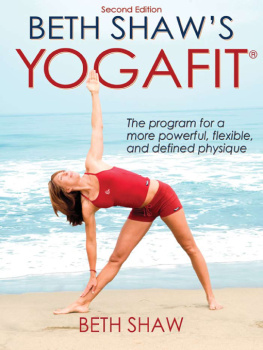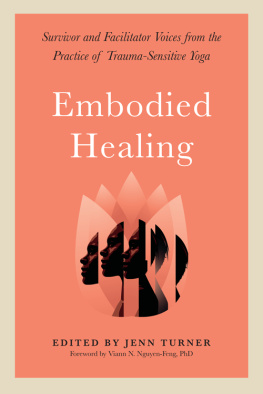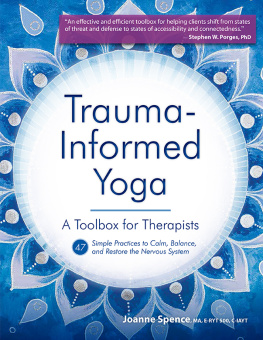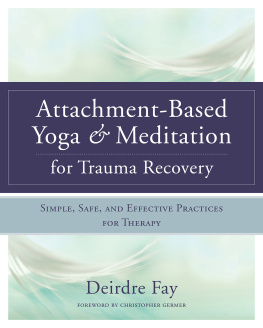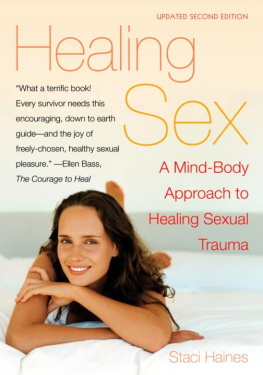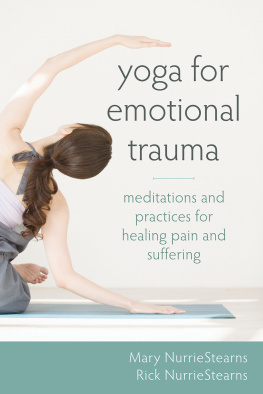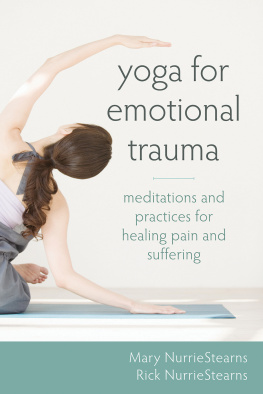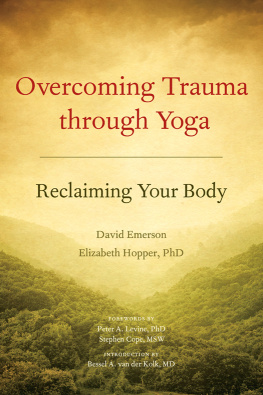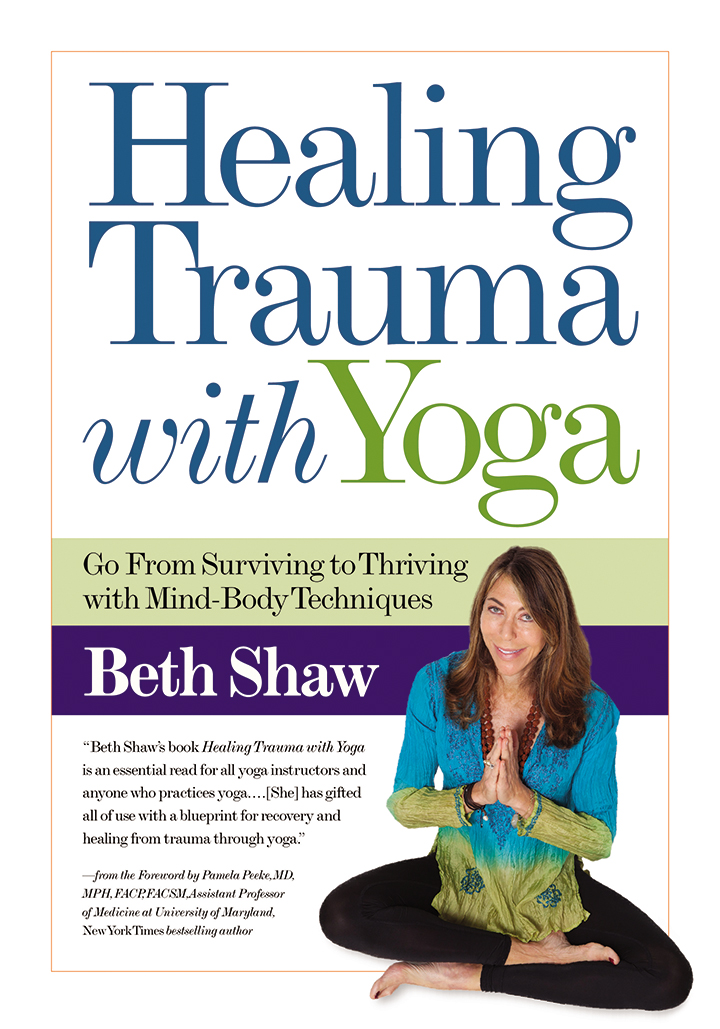Table of Contents
Pagebreaks of the print version

Healing Trauma with Yoga: Go From Surviving to Thriving with Mind-Body Tools
Copyright Beth Shaw, 2019
Published by Blue River Press
Indianapolis, Indiana
www.brpressbooks.com
Distributed by Cardinal Publishers Group
A Tom Doherty Company, Inc.
www.cardinalpub.com
All rights reserved under International and Pan-American Copyright Conventions.
No part of this book may be reproduced, stored in a database or other retrieval system, or transmitted in any form, by any means, including mechanical, photocopy, recording or otherwise, without the prior written permission of the publisher.
ISBN: 978-1-68157-777-7
Cover Design And Book Design: Rick Korab, Korab Company Design
Editors: Danielle Bernabe and Dani McCormick
Photographs: Luciana Pampalone
Printed in the United States of America
10 9 8 7 6 5 4 3 2 1 19 20 21 22 23 24 25 26 27 28
We all breathe the same
universal life-force energy,
May we find healing together,
in unity and community,
As one.
Namaste
TABLE OF CONTENTS
FOREWORD
Yoga teaches us to cure what need not be endured and endure what cannot be cured.
B. K. S. IYENGAR
To be human is to have suffered countless times throughout a life journey. When the pain strikes so deeply that it overwhelms the ability to cope, it transforms into trauma. What is trauma? The Greeks defined trvma or as a wound, indeed one that can pierce to the core an individuals mind, body and spirit, often impairing the ability to feel joy and to function optimally.
Trauma itself is in the eyes of the beholder. The same life event can be perceived very differently from one person to another when viewed through the lens of that individuals life experience. Genetics and environment play major roles in shaping reactions to the full spectrum of life challenges, which can include any form of abuse as well as grief and loss, difficult relationships, distressing world events, and health conditions. Clearly, severe physical and mental abuse can be profoundly traumatic for most people, burdening them with fear, distrust, difficulty connecting with others, and constant, exhausting hypervigilance.
At the heart of optimal trauma management is the ability to practice stress-resilience. This means that, when an individual perceives a stress that is deeply wounding, instead of defaulting to potentially self-destructive trauma behavior, she finds a way to navigate the challenge by productively adapting and adjusting to her circumstances. Thus, the key to survival in the face of traumatic experiences is the daily practice of stress-resilience through regrouping, re-centering, resetting, and rejuvenating.
What better way to become mentally, physically, and spiritually strong than through the regular practice of yoga?
No one is immune to lifes stresses and traumas. Some are fortunate and are stress-resilient enough to adapt and adjust to mental and physical wounds inflicted during the course of their lives. Others become entangled in traumas aftermath, struggling to survive under the dark clouds of anguish and distress. In the end, we all live in recovery, as we confront each days tasks and challenges. Yoga, then, can become a key part of our ongoing healing and recovery process, a life-course that continues until our final breath.
Central to experiencing yoga is the celebration of profoundly self-compassionate holistic connections between mind and body. This counters one of the principal consequences of traumamental and physical dissociation, a common coping mechanism to numb incessant pain and angst. The gentle yet powerful yoga asanas can help heal trauma-related disconnects. Simply learning the pranayama breath practices can be a miraculous event as one feels the body accepting each breath through the expanding chest and abdomen, all the while awakening to the mindful gratitude of just being. To address the need for more trauma focus, the yoga community has begun to develop new training and educational platforms to include trauma-sensitive and trauma-based yoga practices.
Recently, scientists have begun to study the relationship between yoga practice and post-traumatic stress disorder (PTSD) in a variety of populations. One study of military veterans noted:
There was significant improvement in PTSD hyperarousal symptoms and overall sleep quality as well as daytime dysfunction related to sleep.... These results suggest that this yoga program may be an effective adjunctive therapy for improving hyperarousal symptoms of PTSD including sleep quality. This study demonstrates that the yoga program is acceptable [and] feasible, and that there is good adherence in a Veteran population.
Renowned trauma therapist Dr. Bessel Van Der Kolk, Director of the Trauma Research Foundation, was one of the first scientists to utilize yoga in both trauma therapy recovery, as well as research studies. In studying the neuroscience of self-awareness in women with chronic PTSD, Van der Kolk found that a twenty-week extended yoga treatment resulted in significant reductions in the symptoms of PTSD and mind-body dissociation. In his seminal text The Body Keeps the Score:Brain, Mind and Body in the Healing of Trauma,Van der Kolk notes:
Traumatized people chronically feel unsafe inside their bodies: The past is alive in the form of gnawing interior discomfort. Their bodies are constantly bombarded by visceral warning signs, and, in an attempt to control these processes, they often become expert at ignoring their gut feelings and in numbing awareness of what is played out inside. They learn to hide from their selves.
Individuals afflicted with PTSD frequently do not feel safe in their bodies. They are easily triggered by any form of sensory stimulation, especially touch. When this occurs, immediate panic and anxiety ensue. Trauma-informed yoga instructors are keenly aware of this critical threat to the wellbeing of their yoga student. Now students can take that power into their own hands.
Beth Shaws book Healing Trauma with Yoga is an essential read for anyone who has experienced trauma, practices yoga, or teaches yoga.
This book is very timely. Today, individuals are becoming more aware of the effect of long-term stress and trauma on their mind-body. Im certain that women and men who live with PTSD will be greatly relieved to know that there is a safe haven, a yoga class led by a well-trained, compassionate, understanding instructor who is sensitive to the presence of their ongoing and often tenuous healing process. YogaFit has trainings specifically geared toward trauma so instructors are well-equipped and compassionate. This book gives the tools to help people heal themselves. In this book, beyond just tools and techniques, Beth shares insights into the world of trauma, including her own personal story. She genuinely understands the desperate need for traumatized people to develop trust with their yoga instructors and themselves and their own practice. It is from this profound passion and desire to be of service to people who are seeking help from their life traumas that Beth Shaw has gifted all of us with a blueprint for recovery and healing through yoga and mind-body tools.
Pamela Peeke
MD, MPH, FACP, FACSM
Assistant Professor of Medicine, University of Maryland


